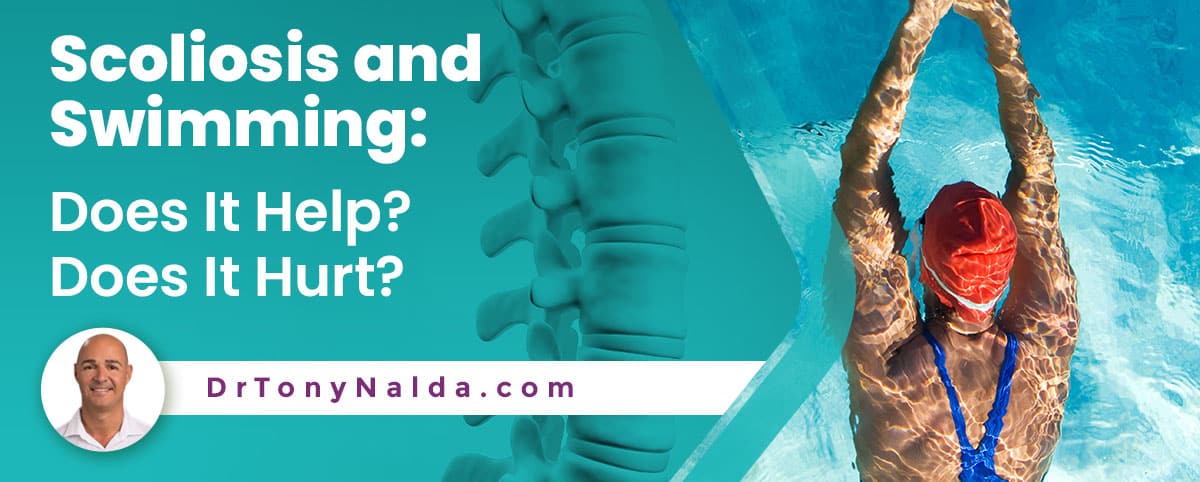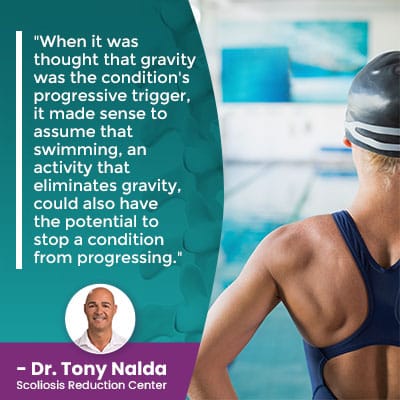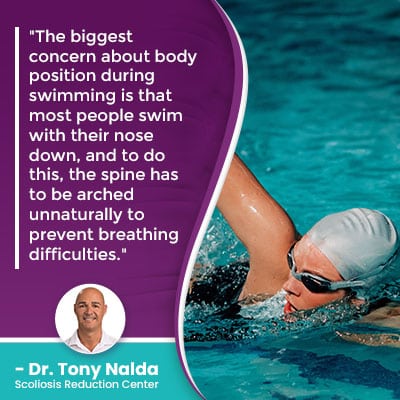Scoliosis and Swimming: Does It Help? Does It Hurt?

There was a time when swimming was thought to be a form of scoliosis treatment due to the weightless environment preventing progression, but now we know the condition's progression has more to do with growth/development than gravity; swimming is now viewed more as a means of maintaining overall health, flexibility, muscle strength, and helping with pain relief.
The complex nature of scoliosis necessitates a treatment approach that combines different scoliosis treatment options. While swimming can be beneficial by working the body's muscles symmetrically, keeping the spine as flexible as possible, and pain relief, it's not a form of treatment.
Gravity, at one time, was thought to be the main cause of progression, but we've since learned that's not the case.
Table of Contents
What is Scoliosis?
With current estimates at approximately 7 million people living with scoliosis in the United States alone, it's a highly-prevalent spinal condition.
Scoliosis means a person's spine curves sideways unnaturally, and rotates, meaning the spine both bends and twists unnaturally.
In addition, as a progressive condition, scoliosis has it in its nature to worsen over time, particularly if left untreated; even mild cases are virtually guaranteed to get worse.
So where a scoliosis is when it's first diagnosed doesn't mean that's where it will stay, which is why proactive treatment is so important.
Understanding Scoliosis Progression
When scoliosis is first diagnosed, part of the process is further classifying conditions based on key patient/condition variables, one of which is condition severity.
Condition severity is determined by a measurement known as Cobb angle, taken during X-ray, and the higher the Cobb angle, the more severe the condition: mild, moderate, severe, or very severe.
The severity levels of scoliosis are also its progressive line; even scoliosis diagnosed as mild can easily progress to become moderate, severe, and very-severe scoliosis.
As mentioned, there was a time when scoliosis progression was thought to be caused by gravity, but our understanding of the condition has grown over the years, and we've since learned that gravity doesn't trigger the condition to progress, growth and development does.
Gravity and Scoliosis
There are three times in life when the body is not subject to gravity, and that's in space, in the womb, and when in water.
While there are different types of scoliosis, adolescent idiopathic scoliosis (AIS), diagnosed between the ages of 10 and 18, is the most prevalent, and the idiopathic designation means we don't know why it developed, to put it plainly.
But we do understand what triggers progression in children and adolescents, and that's growth.
It's the lengthening motion the spine experiences during growth that triggers the unnatural spinal curve to increase in size, not gravity, as was once thought.
 When it was thought that gravity was the condition's progressive trigger, it made sense to assume that swimming, an activity that eliminates gravity, could also have the potential to stop a condition from progressing.
When it was thought that gravity was the condition's progressive trigger, it made sense to assume that swimming, an activity that eliminates gravity, could also have the potential to stop a condition from progressing.
As we grew to understand that progression was more related to growth, views on the role of swimming as a form of treatment also changed, and now, for people with scoliosis, swimming is regarded as more of a positive general exercise, but continued swimming for long periods of time and swimming competitively should be approached with caution by people with scoliosis.
Swimming and Scoliosis
Swimming can be a good activity for people with scoliosis in terms of maintaining general strength and fitness, but it can be harmful to swim competitively.
The research on scoliosis and swimming remains unclear, but it is an activity that's been studied for how it affects scoliosis progression in children, with some data suggesting that when people with scoliosis are removed from their natural environment, including its compressive force of gravity, the body is strengthened by its efforts to counteract gravity.
But for people who swim competitively, they are in the pool for anywhere between 4 and 6 hours a day, and eliminating that feedback by its unnatural body positioning can have negative effects.
When activities, sports, and exercises are deemed helpful or harmful for scoliosis patients, it's based largely on body positioning during the activity in question; for example, sports that overuse one side of the body are thought to exacerbate the condition's asymmetrical effects by placing uneven loads on the spine.
As scoliosis introduces a lot of uneven forces to the body, which is why its main symptom in children and adolescents is postural deviation, sports and activities that can help scoliosis are those that counteract those effects.
Swimming with Scoliosis and Body Position
As mentioned, when it comes to scoliosis, body position is important because the spine is already dealing with adverse spinal tension, so we don't want to introduce any additional uneven forces to the back and body.
One way that swimming is helpful for scoliosis is that it works the body's muscles symmetrically, and increasing core strength is a facet of proactive treatment as the spine needs support from its surrounding muscles; however, swimming can also involve the body being put in an unnatural position.
 The biggest concern about body position during swimming is that most people swim with their nose down, and to do this, the spine has to be arched unnaturally to prevent breathing difficulties.
The biggest concern about body position during swimming is that most people swim with their nose down, and to do this, the spine has to be arched unnaturally to prevent breathing difficulties.
Any body position that involves flattening or arching the thoracic spine (middle/upper back) isn't good for people with scoliosis as it could potentially stimulate progression.
And activities (swimming, dance, and gymnastics) that promote a flatter back are also thought to increase the risk of progression by facilitating a loss of normal kyphosis in the thoracic spine.
Swimming uses spine-flattening movements similar to dance and gymnastics; it's just that it's being done while lying down in water, versus standing upright.
So while swimming can help with keeping the spine flexible and strong, as well as its surrounding muscles, and for those experiencing scoliosis back pain, it can provide pain relief, it can also expose the spine to adverse tension by placing it in unnatural positions.
While swimming won't cause scoliosis to develop or cause a small scoliotic curve to progress from 20 to 100 degrees, it can factor into a patient's progressive rate.
So this is where I go back to saying that scoliosis can be helpful as a general exercise, but not a competitive one.
Swimming Can be Helpful for Scoliosis as a General Exercise
As stated earlier, swimming can be helpful for scoliosis, when used in moderation.
Swimming is a healthy form of exercise that facilitates symmetrical muscle development, and as muscle imbalance is an effect of scoliosis, swimming can help in that regard.
Swimming can also help patients maintain overall levels of health and fitness, making the body more responsive to treatment.
For adults with scoliosis, for whom the condition is compressive, back pain can be a challenge, and swimming, with its weightless effect, removes the compressive force of gravity, so can provide a natural non-invasive form of pain relief.
So, basically, if a person is swimming casually for a few times a week for limited amounts of time, it's less likely to affect progression and flatten the spine excessively.
For those swimming competitively, they are likely in the pool five days a week for up to 6 hours a day, and this is when it can become problematic; however, I should be clear that the same can be said for most competitive sports requiring a certain amount of time and intensity.
While we know that a stronger core is good for people with scoliosis, we don't know that it can actually counteract progression, so the core-strengthening benefits of swimming for people with scoliosis can't negate the potential connection between swimming, body position, and stimulating progression.
We also understand that scoliosis progresses due to growth and development, not because of a weak core, which explains why scoliosis is most commonly diagnosed during adolescence.
Conclusion
I find when people ask if swimming is helpful for scoliosis, they are asking two things: can swimming help correct scoliosis, and can it help people suffering with related back pain?
In terms of correcting a scoliosis, only impacting the condition on a structural level, which means altering the position of the most-tilted vertebrae of the curve, can actually facilitate corrective treatment results, and that's far beyond the scope of swimming.
For those experiencing scoliosis-related back and muscle pain, swimming can be a helpful means of achieving pain relief.
Working the muscles symmetrically can also help address areas of muscle imbalance, known as an effect of scoliosis, and a person suffering from joint and muscle pain can benefit from the weightless environment of swimming.
I should also say that no activity, swimming or otherwise, should be attempted before first clearing it with a patient's scoliosis treatment provider to make sure it's safe for each individual patient's condition/curvature type.
So when it comes to swimming and scoliosis, using it as a general exercise can be helpful, but professional athletes who swim competitively should approach it with caution.
Here at the Scoliosis Reduction Center, treating scoliosis involves fully customizing treatment plans to address important patient/condition variables, and this is done by integrating multiple forms of condition-specific treatment: chiropractic care, physical therapy, corrective bracing, and rehabilitation.
Dr. Tony Nalda
DOCTOR OF CHIROPRACTIC
After receiving an undergraduate degree in psychology and his Doctorate of Chiropractic from Life University, Dr. Nalda settled in Celebration, Florida and proceeded to build one of Central Florida’s most successful chiropractic clinics.
His experience with patients suffering from scoliosis, and the confusion and frustration they faced, led him to seek a specialty in scoliosis care. In 2006 he completed his Intensive Care Certification from CLEAR Institute, a leading scoliosis educational and certification center.
About Dr. Tony Nalda
 Ready to explore scoliosis treatment? Contact Us Now
Ready to explore scoliosis treatment? Contact Us Now





